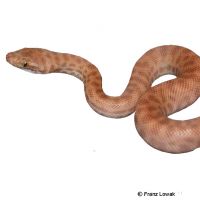Children's Python (Antaresia childreni)
| Children's Python Antaresia childreni | |
|---|---|
| Name | Children's Python |
| Name Lat. | Antaresia childreni |
| Family | Pythons |
| Family lat. | Pythonidae |
| Order | Scaled Reptiles |
| Order lat. | Squamata |
| Origin | Australia |
| Habitat | Savanna |
| Diet | Small mammals |
| Humidity | 40-60 % |
| Behavior | Semi-aggressive |
| Keeping | Individual, pair |
| Care Level | Moderate |
| Reproduction | Oviparous |
| Housing | Semi-humid terrarium |
| Life Span | 15-20 years |
| Protection | CITES Appendix II; EU Annex B |
| Metric Units | |
| Size | 80 cm |
| Temperature | 25-30 °C |
| Temperature Local | 30-33 °C |
| Housing Size | 120 x 60 x 80 cm |
| US Units | |
| Size | 31" |
| Temperature | 77-86 °F |
| Temperature Local | 86-91 °F |
| Housing Size | 45" x 25" x 30" |
Distribution and habitat
The range of the predominantly crepuscular and nocturnal Childrens Pythons is in northern Australia, where they inhabit a variety of habitats including moist forests, scrublands, eucalypt savannas, and desert-like areas. They are ground dwellers, but also like to climb.
Maintenance
Recommended minimum dimensions for the terrarium, according to the size and number of animals:
| 1-2 animals | 1KL x 0,5KL x 0,75KL (L x W x H) |
Body length (KL) is measured on the largest animal. For each additional animal the floor space should be increased by 20%. A terrarium of e.g. L 120 x W 60 x H 80 cm is recommended, which should be placed in a quiet and vibration-free place.
They need a terrarium structured with roots, branched climbing branches, cork tubes and bamboo sticks (hiding places and visual protection), a moisture-retaining substrate, e.g. of bark mulch-soil mixture with peat and foliage, a moist shelter (Sphagnum moss) and a large, easy-to-clean water basin. One quarter of the substrate should be kept permanently slightly moist. Once a day, preferably in the evening, the inside of the terrarium should be finely sprayed with water (humidity), but a rain or mist system is better
| Temp. day: 25-30 °C | Temp. night: 22-24 °C | Temp. local: up to 33 °C | Humidity: 40-60 |
Thermostatically controlled floor heating is recommended. Lighting duration must be 12-14 hrs. depending on the season. Daylight fluorescent tubes are ideal.
Diet
According to their size, they feed on mice, rats, guinea pigs and other rodents, as well as chicks. After acclimation, they often succeed in switching to dead food animals. Juveniles should be offered food every 8-10 days, adults every 14-20 days, with occasional periods of fasting (e.g., skipping a feeding). If it does not eat for an extended period, both the timing and the food should be varied. Basically, it is better to offer several small feeders, rather than one very large one. It is important to enrich the food animals with vitamins and minerals. Since the snake could be injured by live rodents, it should not be left unattended with them.
A varied diet promotes health and prevents deficiency symptoms.
Reproduction and breeding
Probing by a veterinarian is a reliable method of sex determination.
The female lays her eggs (approx. 15) in the moist substrate and performs brood care. The incubation period is about 60 days at a temperature of 27-30 °C.
The life expectancy can be 15-20 years.
Species protection
The animal population must be reported in writing to the responsible authority immediately after the beginning of the keeping. It is essential to find out about any bans on keeping or permits for keeping dangerous animals in your state or municipality (e.g. public order office). Your pet store will be happy to provide you with further information.
Protection of species: WA appendix II; EU appendix B. The proof of purchase is the required proof of origin for the animal. Please keep it safe!
Important
In older animals the spotted pattern may partially fade. Young animals should be kept individually. There is a risk of respiratory infections if kept too dry and if the air temperature is lower than the temperature in the water tank. For the resting phase, shorten the lighting time by 2-4 hours for 1-3 months and lower the temperature by 3-4 °C, depending on the origin. When handling always have snake hooks, protective gloves and cold water ready.
The terrarium must have good ventilation without drafts and meet the species specific needs. Measuring devices such as thermometers, hygrometers, etc. are necessary. The lighting has to correspond to the species-specific day-night rhythm and has to be placed in such a way that the animals cannot injure themselves. The terrarium should be locked in such a way that neither unauthorized persons can open it nor the animals can escape. Contamination must be removed regularly
Further literature can be found in your pet store.
References
Text: Clemens Kapsreiter; Image: Franz Lowak
Source: BMELV (1997): Tierschutzgutachten - Mindestanforderungen an die Haltung von Reptilien; ENGELMANN (2006): Zootierhaltung - Tiere in menschlicher Obhut: Reptilien und Amphibien, Harri Deutsch Verlag
- Gemäß § 21 Abs. 5 Tierschutzgesetz idgF
